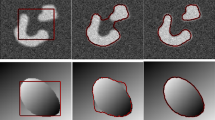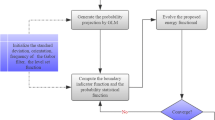Abstract
Purpose
As a key technology in high-intensity focused ultrasound (HIFU) ablation systems, a precise ultrasound image segmentation method for tumor boundary detection is helpful for ablation of tumors and avoiding tumor recurrence. This study explores a new deformable snake model called multi-scale generalized gradient vector flow (MS-GGVF) to segment ultrasound images in HIFU ablation.
Methods
The main idea of the technique is dealing with two issues including spurious boundary attenuation and setting the standard deviation of the Gaussian filter. We assign the standard deviation as scales to build the MS-GGVF model and create a signed distance map to use its gradient direction information and magnitude information to refine the multi-scale edge map by attenuating spurious boundaries and highlighting the real boundary. In addition, a fast generalized gradient vector flow computation algorithm based on an augmented Lagrangian method is introduced to calculate the external force vector field to improve the computation efficiency of our model.
Results
The experimental segmentations were similar to the ground truths delineated by two medical physicians with high area overlap measure and low mean contour distance.
Conclusion
The experimental results demonstrate that the proposed algorithm is robust, reliable, and precise for tumor boundary detection in HIFU ablation systems.







Similar content being viewed by others
References
Kennedy JE. High-intensity focused ultrasound in the treatment of solid tumours. Nat Rev Cancer. 2005;5:321–7.
Crouzet S, Rebillard X, Chevallier D, et al. Multicentric oncologic outcomes of high-intensity focused ultrasound for localized prostate cancer in 803 patients. Eur Urol. 2010;58:559–66.
Wu F, Wang ZB, Zhu H, et al. Extracorporeal high intensity focused ultrasound treatment for patients with breast cancer. Breast Cancer Res Treat. 2005;92:51–60.
Kennedy JE, Wu F, Ter Haar GR, et al. High-intensity focused ultrasound for the treatment of liver tumours. Ultrasonics. 2004;42:931–5.
Kennedy JE, Ter Haar GR, Cranston D. High intensity focused ultrasound: surgery of the future? Br J Radiol. 2003;76:590–9.
Rouvière O, Gelet A, Crouzet S, et al. Prostate focused ultrasound focal therapy—imaging for the future. Nat Rev Clin Oncol. 2012;9:721–7.
Curiel L, Souchon R, Rouviere O, et al. Elastography for the follow-up of high-intensity focused ultrasound prostate cancer treatment: initial comparison with MRI. Ultrasound Med Biol. 2005;31:1461–8.
Solovchuk MA, Sheu TWH, Thiriet M, et al. On a computational study for investigating acoustic streaming and heating during focused ultrasound ablation of liver tumor. Appl Therm Eng. 2013;56:62–76.
Wu F, Wang ZB, Chen WZ, et al. Extracorporeal high intensity focused ultrasound ablation in the treatment of 1038 patients with solid carcinomas in China: an overview. Ultrason Sonochem. 2004;11:149–54.
Wu F, Wang ZB, Zhu H, et al. Feasibility of US-guided high-intensity focused ultrasound treatment in patients with advanced pancreatic cancer: initial experience 1. Radiology. 2005;236:1034–40.
Wu Q, Zhou Q, Zhu Q, et al. Noninvasive cardiac arrhythmia therapy using high-intensity focused ultrasound (HIFU) ablation. Int J Cardiol. 2013;166:e28–30.
Zhang L, Chen WZ, Liu YJ, et al. Feasibility of magnetic resonance imaging-guided high intensity focused ultrasound therapy for ablating uterine fibroids in patients with bowel lies anterior to uterus. Eur J Radiol. 2010;73:396–403.
Noble JA, Boukerroui D. Ultrasound image segmentation: a survey. IEEE Trans Med Imaging. 2006;25:987–1010.
Savelonas MA, Iakovidis DK, Legakis I, et al. Active contours guided by echogenicity and texture for delineation of thyroid nodules in ultrasound images. IEEE Trans Inf Technol Biomed. 2009;13:519–27.
Kass M, Witkin A, Terzopoulos D. Snakes: active contour models. Int J Comput Vis. 1988;1:321–31.
Cohen LD. On active contour models and balloons. CVGIP Image Underst. 1991;53:211–8.
Cohen LD, Cohen I. Finite-element methods for active contour models and balloons for 2-D and 3-D images. IEEE Trans Pattern Anal Mach Intell. 1993;15:1131–47.
Xu C, Prince JL. Snakes, shapes, and gradient vector flow. IEEE Trans Image Process. 1998;7:359–69.
Wu Y, Wang Y, Jia Y. Adaptive diffusion flow active contours for image segmentation. Comput Vis Image Underst. 2013;117:1421–35.
Li Z, Xu X, Le Y, et al. An improved balloon snake for HIFU image-guided system. J Med Ultrasonics. doi:10.1007/s10396-014-0536-x.
Xu C, Prince JL. Generalized gradient vector flow external forces for active contours. Sig Process. 1998;71:131–9.
Tang J, Acton ST. Vessel boundary tracking for intravital microscopy via multiscale gradient vector flow snakes. IEEE Trans Biomed Eng. 2004;51:316–24.
Tang J, Millington S, Acton ST, et al. Surface extraction and thickness measurement of the articular cartilage from MR images using directional gradient vector flow snakes. IEEE Trans Biomed Eng. 2006;53:896–907.
Seroussi I, Veikherman D, Ofer N, et al. Segmentation and tracking of live cells in phase-contrast images using directional gradient vector flow for snakes. J Microsc. 2012;247:137–46.
Le Y, Xu X, Li Z, et al. A multi-step directional generalized gradient vector flow snake for target tumor segmentation in US-guided high-intensity focused ultrasound ablation. Biomed Signal Process Control. 2013;8:811–21.
Ren D, Zuo W, Zhao X, et al. Fast gradient vector flow computation based on augmented Lagrangian method. Pattern Recogn Lett. 2012;34:219–25.
Chuang CH, Lie WN. A downstream algorithm based on extended gradient vector flow field for object segmentation. IEEE Trans Image Process. 2004;13:1379–92.
Qin L, Zhu C, Zhao Y, et al. Generalized gradient vector flow for snakes: new observations, analysis and improvement. IEEE Trans Circuits Syst Video Technol. 2013;23:883–97.
Zhou H, Li X, Schaefer G, et al. Mean shift based gradient vector flow for image segmentation. Comput Vis Image Underst. 2013;117:1004–16.
Lindeberg T. Scale-space theory: a basic tool for analyzing structures at different scales. J Appl Stat. 1994;21:225–70.
Vainberg MM. Variational method and method of monotone operators in the theory of nonlinear equations. New York: Wiley; 1973.
Acknowledgments
The authors would like to thank Wang and his team from Chongqing University of Medical Sciences for providing the medical background as well as the reviewers for their comments. National Basic Research Program 973 of China (Grant No. 2011CB707904).
Conflict of interest
None of the authors have any conflicts of interest.
Ethical standard
This article does not contain any studies with human or animal subjects performed by any of the authors.
Author information
Authors and Affiliations
Corresponding author
About this article
Cite this article
Le, Y., Xu, X., Zha, L. et al. Tumor boundary detection in ultrasound imagery using multi-scale generalized gradient vector flow. J Med Ultrasonics 42, 25–38 (2015). https://doi.org/10.1007/s10396-014-0559-3
Received:
Accepted:
Published:
Issue Date:
DOI: https://doi.org/10.1007/s10396-014-0559-3




